

What I Learned on a Titanic Submarine Expedition
source link: https://nymag.com/intelligencer/2023/06/what-i-learned-on-a-titanic-submarine-expedition.html
Go to the source link to view the article. You can view the picture content, updated content and better typesetting reading experience. If the link is broken, please click the button below to view the snapshot at that time.

What I Learned on a Titanic Sub Expedition
Unraveling the enigma of Stockton Rush — and understanding the Titan tragedy.
This article was featured in One Great Story, New York’s reading recommendation newsletter. Sign up here to get it nightly.
Last summer, for a CBS News Sunday Morning story, I joined OceanGate for a dive on its Titan submersible. I never saw the Titanic. We were only 37 feet below the waves when mission control aborted our dive.
At the time, I thought the reason was pretty dumb: Two capsule-shaped black floats, poorly tied to the sub’s launching platform, had come loose. The floats weren’t part of the sub. They’d have no effect on the dive itself. Who cared about the stupid platform? Let’s GO!
Now, of course, it all looks different. Now, I’m sick to my stomach. Now, I feel like I won at Russian roulette. Three dives later, the Titan imploded and killed the five people onboard.
You can think about our dive’s cancellation in two ways (well, I can). One take: You should never have gotten on that thing. Bad knots should have been a red flag. The other: They’d rather cancel a dive, even for something small, than risk lives. That’s a safety culture.
And right there, in microcosm, is the debate I’ve had with myself for the past year. Stockton Rush, who died in the implosion, was OceanGate’s CEO and the Titan’s designer. Was he a bold innovator, the Elon Musk of submersibles, advancing 50-year-old ideas with modern technologies?
Or was he a con man who cut corners to save money at the cost of his customers’ lives?
This is a journal of the events of that expedition and the evolution of my thinking. It’s also my chance to introduce some new information into the conversation — details that have been missing from the thousands of hours of Titan news coverage so far.
June 13, 2022
“The company OceanGate is offering us three berths aboard their mission to the Titanic July 9–17, departing from St. John’s, Newfoundland, on the 9th. They’re also offering us two spots aboard their submersible on a dive down to the Titanic.”
You can go your whole life without getting an email like that. It came from one of my Sunday Morning producers. Stockton Rush, it seemed, was a fan of the show. There wasn’t much nuance in my response: “LET ME AT IT!!!”
OceanGate had been in business for 14 years. Rush was an aerospace-engineering major at Princeton. (He was also a direct descendant of both Benjamin Rush and Richard Stockton, signers of the Declaration of Independence.) He flew his own airplane. He built it in the ’90s from fiberglass, which was then considered a radical new material. He had bought and refurbished a submersible, then designed and built a second one that he used to take customers on shipwreck dives in the Bahamas. Titan was his third submersible, built for Titanic depths: 2.4 miles down, where the water pressure is 6,000 pounds per square inch.
Each expedition to the Titanic is a nine-day adventure: two sailing days to reach the site, five days over the wreck — five chances to attempt dives — and two days back. They do this whole cycle five times each summer. We’d be on the fourth one of 2022.
My producer, a cameraman, and I booked flights. St. John’s is a quaint fishing town with its own weird time zone, 1.5 hours ahead of New York. It’s the easternmost point of land in North America, so that’s where we’d start.
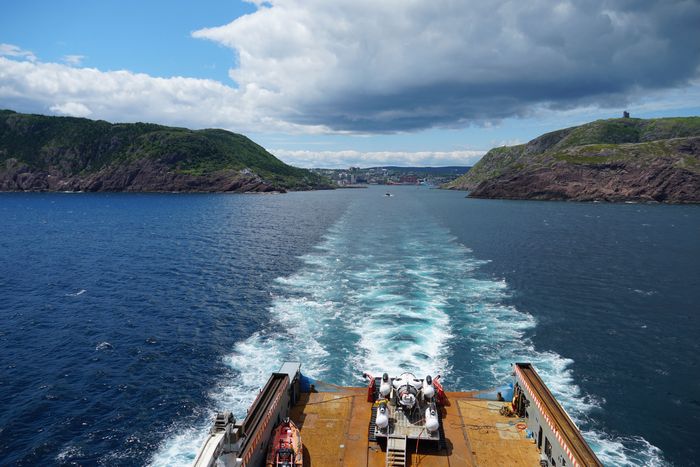
Sunday, July 10, 2022
It’s our first shoot day with Stockton Rush. We meet on the vast back deck of the Horizon Arctic, a 300-foot vessel built for towing offshore oil rigs. Rush has chartered it for the summer to carry his crew, his customers, and his submersible.
Nobody’s allowed on the back deck without a hard hat, goggles, a safety vest, and steel-toed shoes. We’re repeatedly warned that the ship is a dangerous environment — heavy doors, stray ropes, slippery decks — not designed for civilians. Rush looks as you’d expect the descendant of multiple Declaration signers to look: blue eyes, confident, charming, chiseled. And chatty.
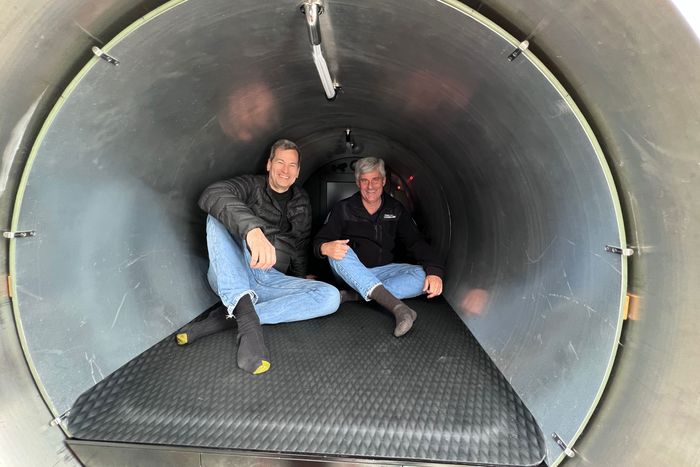
The Titan itself sits on the back lip of the Horizon Arctic’s deck. It spends most of its life bolted to an enormous silver metal platform, five feet tall and about 20 feet square. Titan is a shiny white capsule, 22 feet long. Its primary section is a cylinder of five-inch-thick carbon fiber, capped on each end by a domed titanium endcap. It’s the first submersible ever built of carbon fiber instead of a titanium alloy.
I interview Rush standing near the capsule. The following exchange is from footage of the CBS segment:
RUSH: Carbon fiber is a great material. It’s better than titanium. It’s better than a lot of other materials. But you can have a catastrophic failure where you can have imperfections in the structure. And so you really have to watch how you make it.
POGUE: Well, if one little crack could send you to your death, why did you use it? You don’t need it to be lightweight.
RUSH: Yes, you do. Carbon fiber is three times better than titanium on strength-to-buoyancy. All of a sudden, my pressure vessel is lighter than the water it displaces. So it’s one of the best materials to make a sub out of.
POGUE: Has anyone else said, “Look what Rush did. Maybe we should make ours out of carbon fiber?”
RUSH: No. I don’t think there are a lot of people chasing me on this one, unfortunately. But they will eventually.
I push him on this question. Doesn’t Rush know that carbon fiber has terrible compressive strength? That under enough pressure, it shatters like glass?
“So the key on that one is we have an acoustic monitoring system. Carbon fiber makes noise. It makes noise, and it crackles,” he says. “We have eight acoustic sensors in there, and they’re listening for this. And you get a huge amount of warning. We’ve destroyed several structures [in testing], and you get a lotta warning. I mean, 1,500 meters of warning.”
He describes the tests he ran on this early-alert system, which has gotten very little attention in the news reports. “It’ll start, you’ll go, ‘Oh, this isn’t happy’ — and then you’ll keep doin’ it, and then it explodes or implodes. We do it at the University of Washington. It shakes the whole building when you destroy the thing.”
We climb into the Titan to film a little tour. “Take your shoes off. That’s customary,” Rush says. Most submersible interiors look like submarine cockpits from the ’60s: banks of dials and switches. But the Titan’s interior is modern and featureless. No chairs, no benches, no cockpit. The floor is a black rubber mat Rush bought from a welding-supply company.
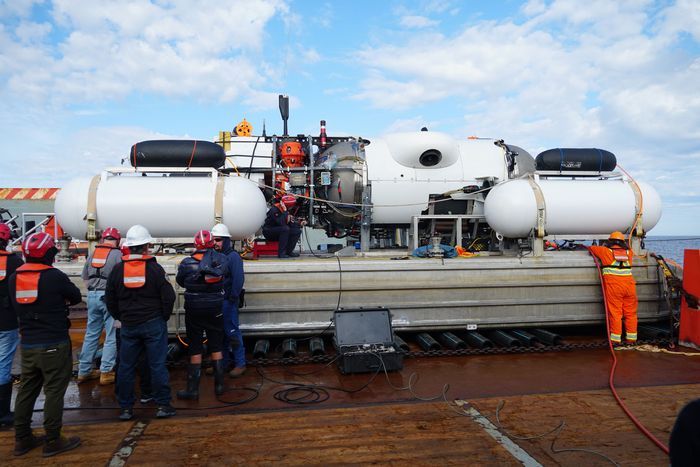
“We only have one button, that’s it,” he says, pushing it for power on the back wall. “This is to other submersibles what the iPhone was to the BlackBerry.” It’s not really just one button, though; two PCs hide behind a panel on the back wall. A pair of touchscreens give readings of depth, oxygen, battery, and so on, and let Rush control the lights and release ballast.
This is when he pulls out the Logitech video-game controller, intended for use with an Xbox or PlayStation: wireless, cheap, and Chinese. “We run the whole thing with this game controller,” Rush says. (This clip from our TV story has racked up 20 million views on TikTok.)
“One of our earlier subs, we developed a controller and it was $10,000, and it was big and bulky. But this thing is made for a 16-year-old to throw it around, and we keep a couple of spares. And so the neat thing is it’s Bluetooth; I can hand it to anyone.”
It still seems like an odd choice, I suggest.
“I like messing with people’s heads,” he says.
The sub has about the space of a minivan. You can’t stand up, but it’s not cramped. The two grab handles on the ceiling feel like the ones in subway cars, except they’re glass and they light up. “I got these from Camping World,” Rush says, grinning.
These handle-lights aren’t attached to the carbon fiber. The sub is lined with a big insert, a perforated metal sleeve, that fits snugly against the carbon fiber, like a rolled-up poster in a mailing tube. “The thing with carbon fiber is you can’t cut holes in it. It doesn’t like that,” Rush says. “Nothing touches the carbon fiber.”
He’s got lights behind the mesh, so the lighting glows through. It looks very cool.
But … welding mat? Camping World? Game controller? I’m supposed to dive in this thing tomorrow.
We have another exchange, also captured in the CBS footage, that feels particularly important in retrospect:
POGUE: It seems like a lot of the way you made this is by taking off-the-shelf parts and sort of MacGyvering them together.
RUSH: Yeah. Pretty much.
POGUE: Does that not raise anybody’s eyebrows in the industry?
RUSH: Oh yeah! Oh yeah. Yeah, no, I’m definitely an outlier. There’s been more intrigue into that than I can go into. There were a lot of rules out there that didn’t make engineering sense to me. They made sense at the time, in the ’60s and ’70s. But, you know, there’s a limit. You know, at some point, safety just is pure waste. I mean, if you just want to be safe, don’t get out of bed, don’t get in your car, don’t do anything. At some point, you’re gonna take some risk, and it really is a risk-reward question. I said, “I think I can do this just as safely by breaking the rules.”
I wonder if he’s trying to play at swashbuckling for our cameras. I mean, he loves tossing out provocative lines.
But inside, I’m not actually worried about safety. For one thing, Rush points out that only the accessories are off-the-shelf parts. “The pressure vessel is not MacGyvered at all because that’s where we work with Boeing and NASA and the University of Washington,” he says. “Once the pressure vessel is — you’re certain it’s not gonna collapse on everybody, everything else can fail. Your thrusters can go, your lights can go. All these things can fail. You’re still gonna be safe.” (Much later, Boeing would say it wasn’t involved with Titan, the University of Washington would say it worked only on Rush’s earlier sub, and NASA would say it consulted on Titan but didn’t actually build it.)
The design redundancies also reassure me. The Titan has two CO2 scrubbing systems, plus emergency oxygen under the floor. It has seven ways to rise to the surface, including air bladders. Some still work if the electronics go out; some work if the hydraulics fail. One works even if everyone aboard is unconscious: It releases sandbags from hooks that dissolve in seawater after 16 hours.
I’m also witnessing what appears to be a serious culture of safety. There are endless checklists, sub inspections, twice-daily mandatory briefings, and a three-strikes rule: If they find three things amiss — even tiny things like low battery power in a flashlight or a missing nut on the platform — they cancel the dive.
At dinner, I hang out with Paul-Henri Nargeolet, the famous French Titanic expert. He has visited the wreckage on 37 dives with five different subs. OceanGate now employs him to accompany the passengers on the dives to narrate what they’re seeing.
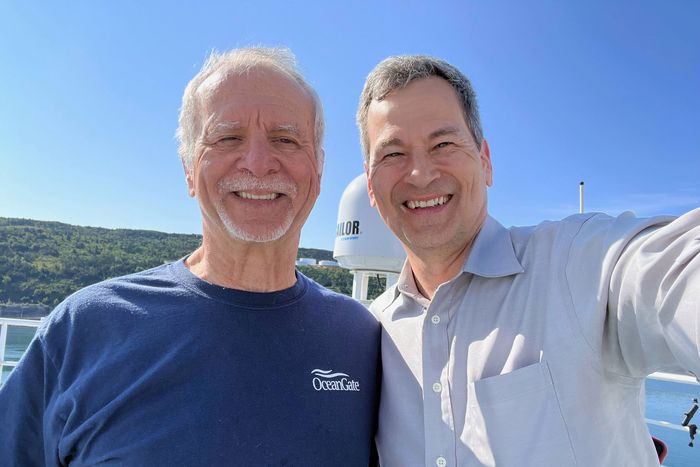
He observed the testing and construction of the Titan and is completely satisfied with its design. “I will say, in the world of the submarine, there was a rule: no carbon fiber,” he says in his French accent, laughing. “But he was working with Boeing, with big company. And when you see the way they were doing the cylinder — it’s not in a garage, you know, with glue and stuff like that. It’s very well done.”
Has there ever been a moment when he worried about the Titan’s safety?
“No. When I saw what it is, I say, ‘Okay. I have no problem to dive in this sub.’”
Rush says that the Titan has already made 20 uneventful dives to Titanic depths, which also calms me. And above all, Rush himself pilots most of them. Why would he drive the Titan if he has any concerns about its integrity?
There is a weirdness to the whole operation, for sure. A press person has instructed me never to call the customers, in my reporting, “passengers,” “customers,” or “tourists.” They’re to be called “mission specialists.” Whatever you call them, they’re paying $250,000 a ticket.
I also know stuff goes wrong in the North Atlantic. In 2021, Mexican YouTuber Alan Estrada filmed the return of the Titan dive before his own. When the sub rose to the surface, the OceanGate crew couldn’t get it back onto the ship. Its occupants spent 27 hours inside before they could be rescued.
I’m slowly realizing the Titan doesn’t actually make it to the Titanic very often. On each of the nine OceanGate expeditions so far, Titan reached the shipwreck twice, once, or not at all. Indeed, Rush explains, that’s why only six paying customers are onboard, enough for two dives; he has learned he can get only two or three good dive days a week. Tomorrow, day one, will be our CBS dive. After that, the selection of “mission specialists” for each dive depends exclusively on Rush’s mysterious internal logic.
But after dinner, we get our own little bad-news bulletin. The waves will be six feet tomorrow. Too rough to launch the platform — and the next two days are expected to be bad weather too. Tomorrow was our only shot. No Titanic for us.
I crash hard. Seeing the Titanic was the whole point of this exhausting trip, wasn’t it? For me and for Sunday Morning?
Rush offers to take us instead to a cool spot on the Grand Banks 80 miles away, one of the richest fishing areas in the world. We might see shark breeding grounds, massive underwater cliffs, or species that nobody’s ever seen before.
I don’t sleep at all. The ship rocks a lot, I have a lot to process, and maybe some lizard-brain survival mechanism is screaming.
Monday, July 11, 2022
Shortly after we arrived on the Horizon Arctic, the entire assemblage of OceanGate staff and paying passengers met for the first of many twice-daily briefings. The six clients made their fortunes in various ways: There’s an Indian mining-company owner, a hedge-fund manager and his 20-something son, the owner of a construction firm, an AI pioneer who has sold ten companies, and a software engineer.
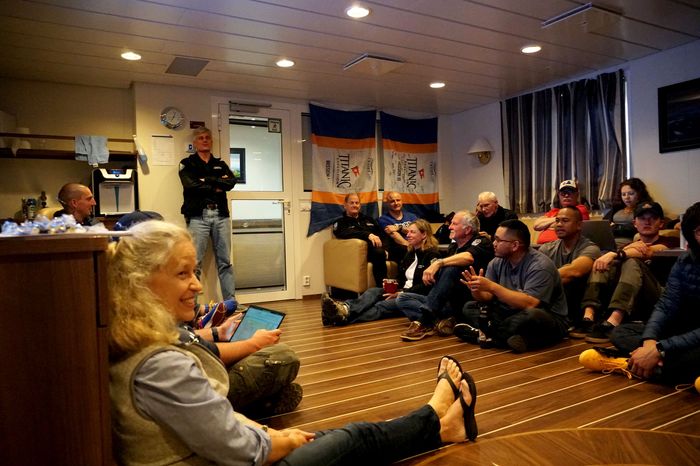
The staff hands out waivers. They read:
RELEASE OF LIABILITY
This operation will be conducted inside an experimental submersible vessel that has not been approved or certified by any regulatory body, and may be constructed of materials that have not been widely used in human-occupied submersibles.
Travel in and around the vessel could result in physical injury, disability, emotional trauma, or death.
The support vessel could expose me to property damage, injury, disability, or death.
Assisting in the operation of the sub could lead to property injury, disability, or death.
“Where do I sign?” I joke on-camera. Honestly, I didn’t think much of it. I assumed it was the usual boilerplate CYA stuff you sign before you go skiing, rafting, or trampoline jumping.
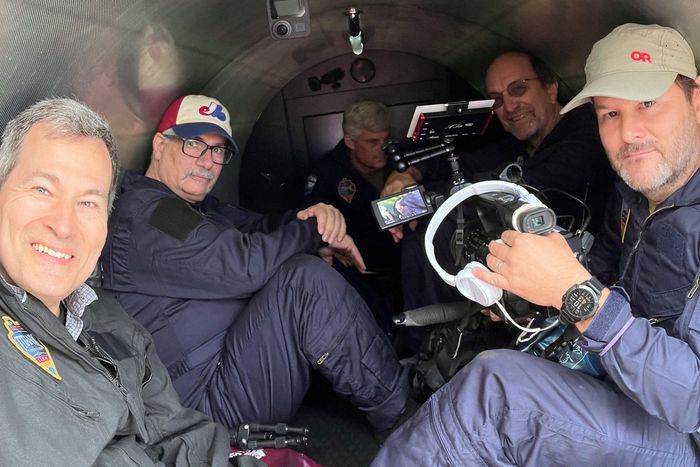
My actual worry on the morning of our dive is that I’ll starve. The dive is supposed to be 10 to 12 hours long, and the sub’s “bathroom” consists of a pee bottle and some Ziploc bags. (There’s a black drape for privacy, and Rush says he cranks up the music while you’re behind it.) That’s why you’re supposed to eat a “low-residue diet” (basically the BRAT diet) the day before your dive. The prep materials instructed us not to bring any food onboard.
As it turns out, the prep materials were wrong. They give you a sandwich and a bottle of water as you board the sub, which we do at 4 a.m. Our dive includes Rush, another passenger associated with the company, marine biologist Steve Ross, CBS producer Anthony Laudato, and me.
The crew closes the hatch and seals us in with the 17 bolts — from the outside. The departure process runs like a rocket launch with countdowns, checklists, and station checks: “Navigation is go for launch,” “Comms is go for launch,” and so on.
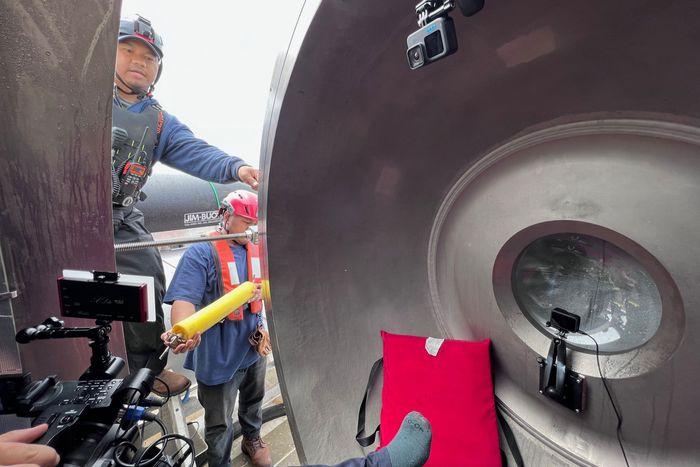
Motorboats are supposed to drag the launch platform off the ship’s deck down a huge bright-orange ramp into the water. The crew will sink the platform and then unclip the sub. The whole idea is to begin propulsion 35 feet below the surface, where the water is calm.
“There’s nothing dumber than doing anything on the surface of the water,” Rush says. “It’s that transition where the problems happen: It’s when you get that sub out of the water, and now it’s not in the water, it’s hanging on a pendulum. That’s the dangerous part.”
Five minutes before we actually move into the sea, we experience what the crew loves to call a “stopski”: a mandatory five-minute halt in the countdown. The point is to quash any procedural momentum that might plow over some team member’s nagging concern. Every station is supposed to take a breath and check their systems one more time.
By the time OceanGate’s motorboats start dragging our launch platform down the ramp, we’ve been in the Titan for hours, five people building up body heat. It’s 94 degrees Fahrenheit in there. We’ve shed the layers and extra socks we’d been told we would need for the bottom of the sea, where the water is below the freezing point.
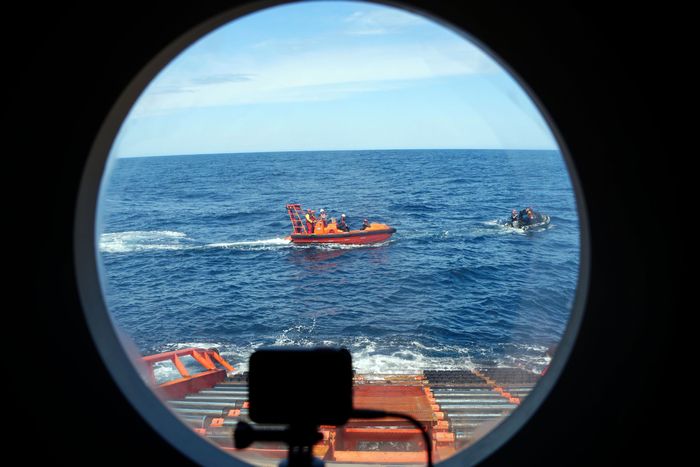
But now, at last, we’re bobbing on the waves. Two OceanGate motorboats zoom around, detaching us from the tow ropes and preparing to let the air out of the platform. After another hour, we are underwater. All rocking stops, and the only sound comes from the computer fans. The single plexiglass porthole, seven inches thick and about 18 inches across, shows us aqua water and rising white bubbles. Scuba divers arrive to unclip our sub from the submerged platform, so we can go see some shark breeding grounds.
That’s when Rush speaks up. “They’re bringing us back up. Something happened.” He calls expedition manager Kyle Bingham, in the control center on the bridge of the ship, on the radio.
“Topside, Titan …” says Rush.
“Go ahead,” answers Bingham.
“So we’re scrubbing?” asks Rush.
“Yeah, that’s the consensus up here,” says Bingham.
“Copy that,” says Rush.
“It’s not an exact science,” Rush tells us, clearly unhappy with having this voyage scrapped because of a couple of untied floaties. “Everything down to knot tying!”
And that was it. After all the sleepless nights, travel, planning, research, and telling everyone I knew about this adventure, we managed to get only 37 feet beneath the ocean surface.
Wednesday, July 13, 2022
Another day of bad weather. Actually, gorgeous weather — sunshine, blue skies — but seas too rough to launch the sub, just like the day before. Man, I’d hate to be one of the $250,000 customers at this point. We’re on day three of the five possible dive days, and they’ve gone nowhere.
Rush tells us we won’t be bored as we wait for better weather. He says maybe we’ll drag chum outside the motorboats just to see what sharks we can attract, or have a motorboat tug-of-war, or fish for mahi-mahi, or shoot the Horizon Arctic’s massive fire hoses way up into the air, just for fun.
None of that happens. We kill the time in other ways, though. We watch a pod of whales spouting their way to wherever they’re going. We make a scavenger hunt around the ship. We decorate 16-ounce Styrofoam cups that Rush will put into a laundry bag outside the Titan on the next dive. At Titanic depth, the pressure will compress them down into “THIS CUP HAS BEEN TO THE TITANIC” souvenirs, one-quarter their original size.
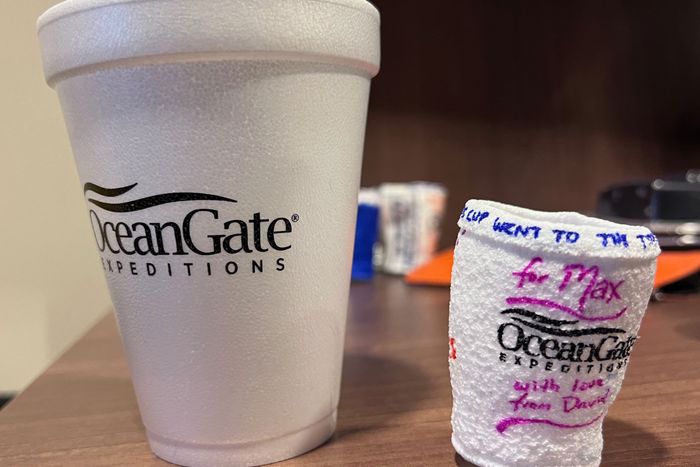
I’m still trying to figure out how buttoned-down this operation is. Every night at the 7 p.m. briefing, Bingham projects a spreadsheet listing things that need fixing, recharging, or replacing before the next dive. He assigns each one to a crew member to make sure it gets done.
I ask Nargeolet later: Is this much maintenance typical on Titanic subs? “Absolutely typical. If people say they do something different, they are lying,” he says. “Every sub is a prototype, okay? It’s not like a car. You use the key and you go, because millions of car are built before. And as a prototype, you have a lot of stuff unknown.”
But what about the Mirs, the pair of Russian submersibles James Cameron used to visit the Titanic for his movie? “Of course! I know the Mir very well,” Nargeolet says. “They have a lot of problem too.” At this point, I’ve endured this concern-and-reassurance cycle so many times I’ve got it memorized.
Thursday, July 14, 2022
The weather and the waves have finally broken our way. Three millionaires are going down to see the Titanic. Good thing, too — this is our second-to-last day above the wreck.
It takes them a little over two hours to descend 2.4 miles. Regular radio waves don’t travel through water, so the sub and control room communicate using very short, coded text messages sent by acoustic pulses through the water column.
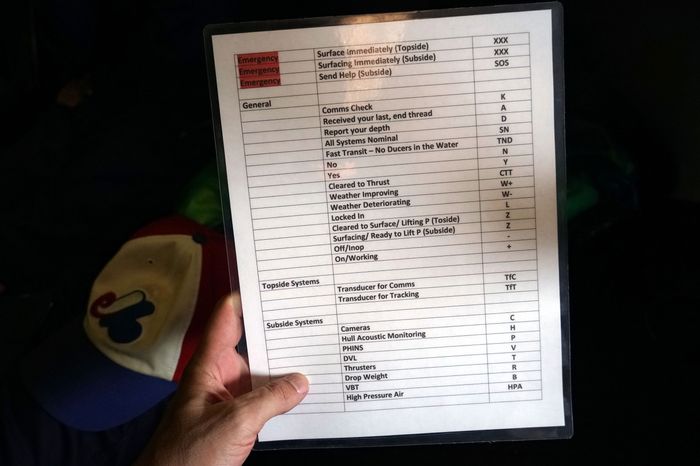
There’s no GPS underwater either, and that’s where the problems begin. Up in the ship’s control room, on a screen, we can see the locations of both the Titan and the two halves of the Titanic. Wendy Rush, Stockton’s wife, runs the show. (As it happens, she’s the great-great-granddaughter of Isidor and Ida Straus, who went down on the Titanic.) She sends text messages to Stockton, who is piloting the Titan, guiding him to the wreck.
“It’s like a game of Battleship,” Stockton had told me. “You’re like, ‘Go to square B-4.’” But on this dive, the directions don’t make any sense. In the sub, Rush has no idea where he is. “They say we’re northwest of the wreck, but the grid position they’re giving us is not correct,” he says in frustration. (We hear all this later when we retrieve our GoPros from the sub.)
“Doesn’t make any sense,” he mutters an hour later. “We’re 100 meters off the bow, now we’re 570 meters off? They have no idea where we are!”
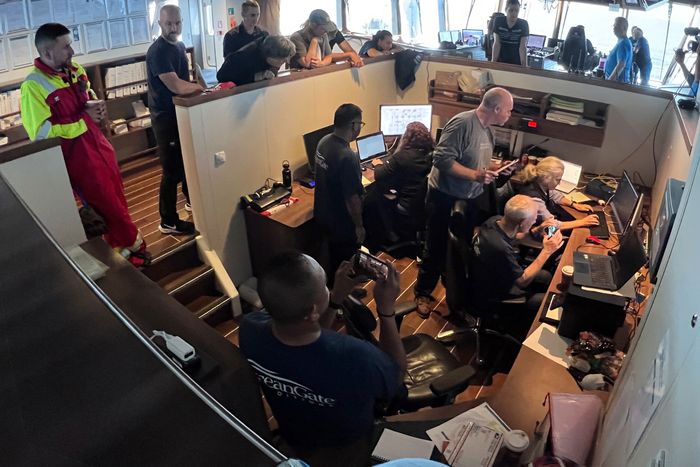
Phil Brooks, then OceanGate’s director of engineering, points out just how blind you are at that ink-black depth. “When you turn on your lights, you can see maybe three meters in front of you,” he told me later. “You’re driving around in pitch darkness. You can be five meters away from the wreck and not know it.”
On this dive, Brooks says, “We were concerned that our primary navigation tracking system was incorrect, so we started to cross-check it with the ship’s GPS system” — and the two signals disagreed with each other.
The ship’s bridge is tense and quiet. The onboard Wi-Fi goes out. I wonder, Is OceanGate trying to prevent us from tweeting bad news? When I ask an OceanGate rep about the Wi-Fi, he tells me it’s just a precaution. If this turns out to be a real emergency, they can’t risk clogged bandwidth.
The Titan passengers have spotted an old Titanic boiler in the debris field, but that’s it. After four hours on the seafloor, Stockton gets the message from Wendy that it’s time to come back up.
OceanGate doesn’t give refunds. But if you don’t see the Titanic, you’re offered a do-over the following summer. It’s free if mechanical problems were at fault, half-price if it was bad weather.
Indian industrialist Shrenik Baldota is on Titan today. He says just going down is cool: “It went from blue to dark blue and then it was pitch-dark. And from 800 meters to 1,500, we could see as if you were in a spaceship and the stars were going by — we had illuminous creatures going down. It was beautiful. Magical.”
Still, he didn’t see the Titanic. “We didn’t find the bow,” he says. “We were lost.”
Friday, July 15, 2022
It’s our last day above the wreck — the expedition’s last chance to reach the Titanic. Nargeolet is aboard Titan as the expert, pilot Scott Griffith mans the game controller, and three more mission specialists climb into the sub.
This time, everything goes right. Up in the control room, I witness their perfect descent, perfect comms, perfect guidance. They approach the wreck with lights on. The famous bow emerges, looming, out of the blackness. “Bow’s directly in front of us,” Griffith says.
“Slow down, slow down! We are in front of the anchor!” Nargeolet says.
“That’s incredible, though. Just darkness, darkness, darkness, and then all of a sudden, it comes straight out! Oh my God. Do you guys see it?” says the hedge-fund manager’s son.
The sub’s external lights are having trouble. They occasionally blink off. But these men’s minds are clearly blown.
“The grand staircase is just here, where it’s black,” says Nargeolet.
“That’s where Jack and Rose first saw each other,” someone jokes.
A few hours later, they’re back on the ship. The entire cast and crew of our expedition greets them. Someone pops open a bottle of bubbly apple juice to celebrate. (The Horizon Arctic is an alcohol-free zone.) Everyone is giddy. Grown men hug each other with all their strength. Later, they’ll say their lives changed when they saw the Titanic.
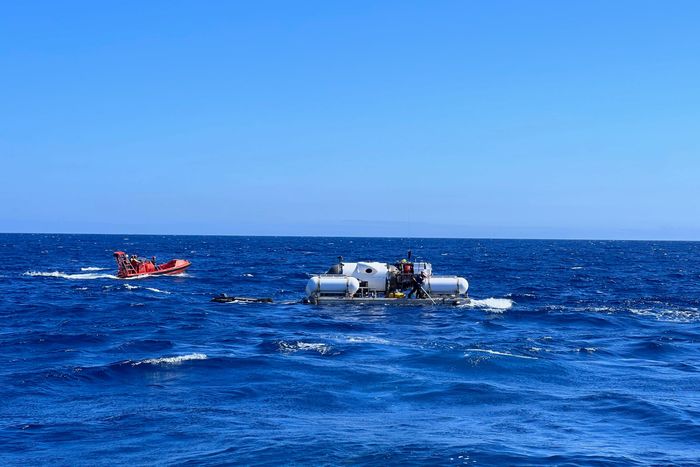
When they show us the video they shot, I can see why: The Titanic is slowly falling apart, but it’s still immense, majestic, and shockingly colorful up close.
Maybe all the little things that break down are just part of doing business in the unpredictable North Atlantic. Maybe the off-the-shelf accessories actually do the job.
Maybe Stockton Rush isn’t so crazy after all.
November 27, 2022
Our ten-minute CBS Sunday Morning story airs. It’s as fair as I could make it: It documents those MacGyvered, off-the-shelf components, the loose buoys, our aborted dive, and the sub getting lost on the seafloor. But it also shows the triumphant final dive, complete with stunning video of the Titanic in all its 4K glory.
OceanGate is very unhappy with the story. Of course, nobody suspects the Titan will last only three more dives.
Thursday, June 22, 2023
They’ve just found the debris of the Titan.
Everyone’s suddenly a carbon-fiber expert. But if you really want to know what happened, I think Alfred McLaren, a retired Navy sub captain who has spent a cumulative 5.75 years of his life underwater, has the most plausible explanation.
It wasn’t the carbon fiber itself. It was the three dissimilar materials: carbon fiber, titanium, and plexiglass. “They have different coefficients of expansion and compression,” he tells me in another CBS interview. “You make repeated cycles in depth, of course you’re gonna work that seal loose.”
The media spent a week counting down the number of oxygen hours the passengers had left. The public went nuts on Twitter, furious that the sub didn’t have an underwater-location beacon, a tether, or a second, accompanying sub. None of it would have mattered; the men have been dead all week. The sub imploded instantly before it even reached the seafloor.
And if the multi-material design actually was the problem, then none of the OceanGate safety protocols mattered either. None of the redundant life-support systems mattered. Even Rush’s beloved acoustic-monitoring system didn’t matter.
I should not have been reassured by the Titan’s 20 successful dives to the seafloor. I should have been terrified. Each dive brought the sub closer to destruction.
Anyone could see that Rush relished playing the maverick genius; more than once, he compared his role as industry disrupter to Steve Jobs and Elon Musk. He seems to have exaggerated the role of Boeing and others and minimized the frequency of Titan’s breakdowns. Now that we know the sub was doomed, we can find a hundred things that should have been done differently.
But I don’t think Rush was a con man. He genuinely believed in his design — enough to trust it with his own life many times over. And for every James Cameron who’s now saying “I saw it coming,” there’s a Nargeolet or a Brooks who knew the sub inside and out and considered it safe.
Looking back, I wonder if Rush’s fiberglass-plane experience taught him the wrong lesson. The critics carped about his use of composites at the time, but now every airplane uses them. Maybe his takeaway was that when experts say you’re wrong about a new material, they’re just calcified thinkers.
“When you’re trying something outside the box, people inside the box think you’re nuts,” he said. “Inside the box, everything’s scary.”
The problem, as we now know, is that in the case of the Titan, the people inside the box had it right all along. For innovators like Rush, sometimes the real trick is knowing when to listen.
One Great Story: A Nightly Newsletter for the Best of New York
Recommend
About Joyk
Aggregate valuable and interesting links.
Joyk means Joy of geeK